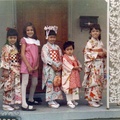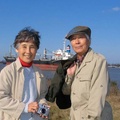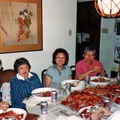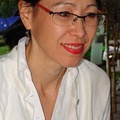Read Part 1 >>
In the oral history tradition, here are some stories from some of the Nikkei’s families in Louisiana:
Imahara family:
A native of Watsonville, California, Nisei James Imahara was a successful Nikkei farmer who raised strawberries and fruit trees in Sacramento. He married Haruka Sunada, a Kibei Nisei and had nine children. Along with other Japanese Americans, the Imaharas were interned in Arkansas, and Mr. Imahara lost his entire life's efforts.
After the War, the Imaharas moved to New Orleans. Although the treatment of Japanese and Japanese Americans could not be compared to that on the West Coast, those early days were difficult and sometimes Nikkei were not well regarded. "Times were rough, rough. I crawled and I cried," recalled the senior Imahara in his memoirs.1 He eventually found work at hatcheries, nurseries and orchards while his wife worked at home making money by sewing.
Their Sansei children wanted to find jobs, but were denied employment because of their race. The years were difficult for Nikkei, but especially for the Imaharas because their family was so large (A 10th child was born after they moved to New Orleans.). Nevertheless, they managed, in part, because the Japanese American community, supported one another.
Like many Japanese and Japanese Americans, education was always highly valued. Despite great adversity, Mr. Imahara sent 8 of his 10 children through college.
His eldest son, Mr. Walter Imahara, obtained a degree in agriculture and together with another daughter, May Imahara Kaga moved to Baton Rouge (100 miles west of New Orleans) where they started their own nursery in 1968. The nursery turned out to be quite a success. The Imaharas were especially knowledgeable and skilled in the care of plants, and they were good at running a business.
Their nursery became famous throughout Southeastern Louisiana for the highest quality plants and service. Looking back, Mrs. Imahara regarded Louisiana as a good choice. Many African Americans did not even know where Japan was, much less Japan's role in the War. The Imaharas found that New Orleanians were kind, and even donated things to their children. Today, the Imahara nursery and landscaping business still flourishes. Mr. Walter Imahara retired to pursue his lifelong passion in championship weightlifting. Imahara’s Landscape Company is currently under the leadership of Yonsei Wanda Metz Chase.
Yenari family:
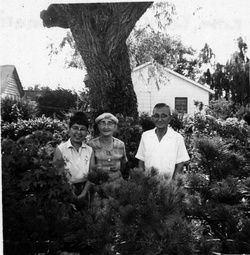
May 1961; Daisuke Yenari’s bonsais with cypress trees in the background, Metairie, LA home; L-R Mrs. Katsu Yenari, Mrs. Kaoru Yenari, Mr. Daisuke Yenari
Daisuke Yenari and his older brother Kanzo came to American in the hopes of selling fireworks to a new market. Instead, they found themselves among the many Issei working in the Seattle sawmills. Though Kanzo Enari returned to Japan to attend to family affairs, Daisuke remained in the US. He married through omiai, Japanese style arranged marriage, and had 3 sons.
They later moved to Los Angeles, where Daisuke Yenari worked as a salesman. The Yenari family was also interned during the War years in Rohwer, Arkansas. Daisuke enjoyed cultivating bonsai during these years, and took this hobby with him to New Orleans, where he became famous for his little dwarf trees. Some credit him with introducing bonsai to the New Orleans people.
The two younger Yenari sons, Susumu and Touru, served in the military intelligence service (MIS), and helped US troops settle in Okinawa. When the concentration camps closed, Hajime eventually found a job as a watchmaker in New Orleans and moved his parents out of camp. The Yenaris rented a multi-bedroom house in one of the suburbs where they subleased rooms to other Nikkei. Former boarders remember the traditional Japanese meals that Mother Kaoru Yenari prepared—something not easy to come by in New Orleans back then.
Because Hajime was bilingual, he could communicate freely with both English and Japanese speakers. As a result, he spent much of his time resurrecting the then defunct Japan Society of New Orleans. Among the many reasons for needing such an organization, a critical one was the need for Buddhist religious services. When a member of the community died, Hajime arranged to have Japanese priests from Chicago conduct funeral ceremonies.
As tourism from Japan increased, he was often asked to interpret for Japanese tourists or help newer Japanese immigrants settle in New Orleans. By 1963, he was elected president of the Japan Society of New Orleans and began the tradition of the annual sukiyaki party. He was respected by the Nikkei community for his generous nature and boundless energy.2
Nisei Dr. Katsu Oikawa, the wife of Hajime, was a general pediatrician. She had been interned in Heart Mountain, Wyoming. Though most of her family resettled in the Midwest, her medical studies brought her to New Orleans for a pediatric residency at Tulane University. She began her professional career in the then rural suburb of Gretna where she was one of only four pediatricians. This was during the late 1950s when segregation was still observed.
She herself had faced racism as a Nisei, but was naive about black-white relations in the Deep South. In fact, she was told she had to sit "in front of the bar" on a public bus because she was regarded as white. Also at that time, white physicians often refused treatment to blacks, but she treated anyone who needed her services. This apparently made a big impression on some of her African American patients who remembered the "little Japanese lady doctor" who didn't care that they were black. Because she could also communicate easily in Japanese, she also cared for Japanese families and their children.
After serving in the MIS, the youngest Yenari son, Touru, went to Chicago to study optometry. By 1950, Dr. Yenari moved to New Orleans to join the rest of his family, and he began a successful practice. He also became involved in the New Orleans tradition of Mardi Gras, viewed by most Americans as one giant party. But there is more beneath the surface.
Many Mardi Gras parades are organized by various private carnival clubs called krewes. And membership in some krewes was not easily obtained for outsiders and non-whites. Unfortunately, this was one time when Southerners made the distinction between "white" and "Oriental." One of the carnival krewes was trying to recruit members of a local business association. Because Dr. Yenari happened to be president at the time, they were obliged to let him join.
He belonged to the Mardi Gras krewe for 10 years, but his first introduction was less than hospitable. Other krewe members did not want to ride on the same float with him because he looked different. But always friendly and with a good sense of humor, he was soon welcomed into the club. Nikkei kids would go to the parades and try to get him to toss them a few extra plastic beads or doubloons. During his retirement, Dr. Yenari became a senior Olympian3 and trained in various athletic events. He went on to win several medals and trophies for a variety of events, including the pole vault.
Notes:
1. Imahara JM, Poindexter AB. Son of Immigrants. Baton Rouge: James M. Imahara, 1982.
2. Gaffney JB. Debt of Honor. Times Picayune. New Orleans, 1990:D-1-2.
3. Grady B. Lad undaunted by WWII internment camp. Times Picayune. New Orleans, 1999.
© 2012 Midori Yenari & Anna Stahl




